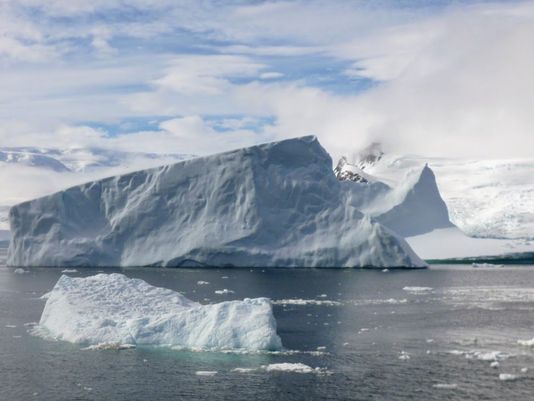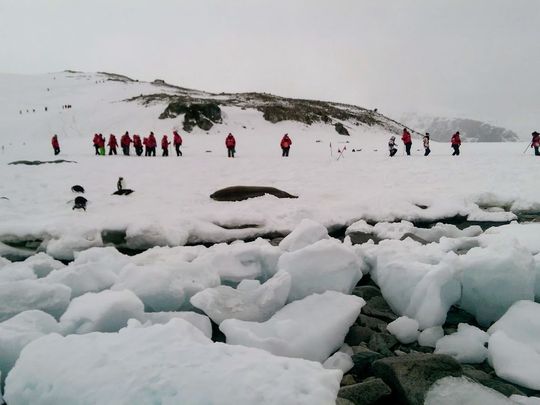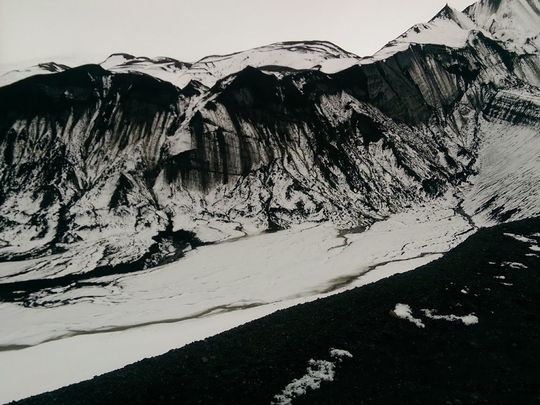Exploring the Wonders of Antarctica
“Exploring the Wonders of Antarctica,” with photographs by Marcia Jacobson, Ithaca Journal, Aug. 6, 2018; https://www.ithacajournal.com/story/entertainment/arts/2018/08/06/review-exploring-wonders-antarctica/913923002/
A photo from NASA shows what might be the end of the journey for a massive iceberg that broke away from Antarctica’s Ross Ice Shelf. Buzz60
Introduction
|
My wife, Marcia Jacobson, and I have traveled quite a bit — I have been to more than 100 countries, she a handful fewer — but we had never been to the seventh continent.
We did not know much about the cruise ship operator Ponant, but the company's dates, trip length, and cost fit into our needs, and we later learned that upscale companies book their clients on their cruises. Although we were on the Ponant Le Boreal for 10 days, nine nights, the round trip from New York City covered 14 days, from Dec. 16 to Dec. 29.
Ponant is a French company with aspirations to expand into the U.S., where they have upped their advertising. Most of the major staff positions are occupied by French speakers, some with little English, but lectures were in English, French, and Chinese.
The cruise director did have trouble with his English and many of his announcements were much clearer for those who knew French than when he rendered them in broken English. It happens that I am reasonably conversant with French, but some of the English-speaking passengers found it frustrating that a few of the naturists knew minimal English.
We booked Ponant through Vacation to Go’s agent, Jules Webbe — who gave us a better price than Ponant, even though I am sure they paid her an additional commission. (She has informed me that this arrangement is no longer possible.)
We took a direct flight from JFK to Buenos Aires, arriving, as Ponant recommended, a day before our trip began, and overnighted at the five-star Park Tower (Starwood). Our Ponant experience officially began the next day with am early morning flight to Ushuaia, which Ponant incudes in their trip fee.
|
Ushuaia is the major city — but really a town — of Tierra del Fuego, the archipelago at the southernmost tip of South America’s mainland. When we arrived, we took a bus to the Tierra del Fuego National Park. We paid $100 per person for this four hour excursion on which we saw some nice scenery and some birds, including black-headed swans and geese, and had a satisfactory lunch featuring meat. hen we returned, we explored Ushuaia before boarding Le Boreal in the later afternoon.
As a first-time Ponant customer, our package included $250 per person for on-board expenses such as laundry, spa massage, and clothing purchases from their shop, all of which are quite expensive. Our tips were included, which is a big plus because inclusion takes that unpleasant aspect of travelling off your mind.
Our Ponant boat, Le Boreal, had 209 passengers and almost 150 crew members. Most of the passengers were from France, Australia and China; the latter came with their own Chinese interpreter, and Ponant had a Chinese-speaking naturalist. Under 20 percent of the passengers were from the U.S. Many of the passengers were well-traveled and they were fitter, younger, and more eager for adventure and learning than the average cruise passengers. Some brought children or grandchildren, but there were not special activities for the children.
A physical challenge for many is the rough water of the Drake passage, which we passed through twice for two days on the way to and from the Antarctic Peninsula. Marcia and I both wore medical patches behind our ears that were prescribed by our doctor to combat motion sickness; we didn’t, like quite a large number of our fellow passengers, get seasick. Neither patches nor pills work for everyone.
During December it is summer in Antarctica. Temperatures are about 32 degrees Farenheit, although the wind-chill factor makes it feel colder, As instructed by Ponant, we brought long underwear, waterproof ski pants and gloves, neck warmers, sock liners, and wool hats as well as trekking poles. Ponant gives passengers a parka to keep and lends you waterproof boots.
|
Antarctica
This proved to be an amazing trip, one that takes its place among trips of a lifetime. Antarctica is a continent; thus there is a land mass under all the ice and snow. We spent five days exploring the Antarctic Peninsula, the northernmost part of the Antarctica continent.
Thinking of Antarctica history, Marcia observed, “Sailing through the icebergs and chunks of ice, you could readily imagine the ice in colder weather crowding in and immobilizing or crushing the ship as happened to whalers and explorers.”
Our expedition, as it was rightly called although we were not dong original research but were on an educational excursion for travellers, featured stunning scenery — notably of glaciers and icebergs is such places as Lemaire channel and Telefon Bay — along with penguins, seals, and whales as well as supportive and educational lectures from well-informed naturalists.
We landed from the motor-powered rubber zodiacs, which hold about 10 people at a time and transport passengers to the landing sites. We may at age 76 have been the oldest couple on Le Boreal who got off at every landing. We climbed over ice and rocks in conditions that tested our fitness. We could see beaches, many hills, beautiful ice and snow formations. Our trekking poles helped negotiate the ice and snow.
Each landing was different, but at almost every stop there was wildlife to see and hills to climb, and we tried to do some of both. In Marcia’s words, “The snow was usually loose and always clean; the ice was varied — different kinds, shapes, and sizes of icebergs, some glaciers, and what looked like ice rubble.”
Because only 100 people are permitted to be at each site at one time, we were divided into four groups, two of which landed within fifteen minutes of each other. The remaining groups landed after the first group returned. Each group had about 90 minute ashore, sometimes a little less.
Our focus was on both the sublime scenery and wild life, most notably penguins (Gentoo, Adelies, Chinstrap, Macaroni), seals (Weddell, Leopard, the huge Elephants,t he males weighing as much as four tons), and humpback whales. We also saw Cape Petrels, Snow Petrels. Antarctic Petrels, Albatrosses (related to Petrels) and Antarctic Shags (related to cormorants).
On our first landing, which was at Neko Harbor we marveled at the Gentoo rookery and the strikingly beautiful terrain with snow and ice virtually untouched by man. This landing was particularly striking because we were in the first group that followed the naturists. Here and elsewhere we saw male and female penguin couples alternately sitting on the eggs as well as newly hatched chicks. Our second excursion the same day was a zodiac ride for 75 or so minutes in the Paradise Bay area; we saw penguins and several other birds, but what again was most spectacular was the scenery, notably glaciers and ice bergs that because of the light were blue and in some cases green. On one landing Dec 23, we visited Port Lockroy , which is maintained by the United Kingdom Antarctic Heritage Trust as a little museum and a post office. We also saw Leopard Seals there.
On Christmas Day, we awoke to see a huge iceberg and the spectacle of our boat surrounded by many smaller ones. Another thrill that day was our landing on the brown ash beach of a volcano called Brown Bluff where we saw an estimated 20, 000 Adelie penguins, including parents feeding chicks as well as a rare albino penguin. Before climbing to the top of the volcanic cone which yielded an extraordinary view, we watched the penguins interact with one another and learned that they are not very social; outside of their relationship with their mates, they often fight among themselves. In the words of one of the expedition’s naturalists, “They hate one another.”
I cannot begin to describe all the wonders of our five days Antarctica. One morning, we were awakened to watch humpback whales cavorting in proximity to our boat. But that paled to our whale watch a few days later as we began our journey back when we saw from the Captain’s bridge the most amazing whale display that we had ever seen, including our whale watching excursions in Provincetown. For over an hour we watched humpback whales majestically diving and breaching , that is jumping out of the water and acrobatically whirling around.
One day we were told that a leopard seal jumped into a zodiac tied to the Le Boreal and stayed the entire morning. I was a little skeptical that this was not induced by our wily naturalists, but enjoyed the event as much as the other passengers.
On another day we awoke to see stunningly beautiful icebergs as we entered the narrow passage to Deception Island which is an active volcano calderas and hence has black sand on the landing beach. We were able to get close to three Weddell seals, two young ones and a mature one, before beginning a steep climb of 300 meters in considerable snow.
|
Naturalists on board
The naturalists on board are a great asset and their professional presentations add to both the seriousness of the learning experience and the sense of being on an adventure. Pasenegers can sign up for meals with them and talk about aspects of what we are seeing or other aspects of the trip, and we enjoyed doing this twice. Before the passengers disembark the ship on the zodiacs, the naturalists visit each site to mark the terrain so that you know where to walk and where not to go. Penguin alleys/passages are inviolate and every effort is made not to pollute island. For that reason, we washed our boots coming and going. The naturalists are very careful in helping you get in and out of the zodiacs, and instruct you how to hold on and how to enter and exit the zodiacs. Falling into the icy water would not be pleasant, but if it happens they pull you out immediately. By the time the zodiacs land some of the naturists are spread out along the terrain to guide you, But after that you are on your own.
I have one suggestion that borders on criticism. We and some others to whom I spoke thought one of naturalists should have accompanied those passengers who wanted a hiking guide. I had never been on a trip, especially a nature trip, where we were not accompanied by someone explaining what we were seeing as we were seeing it and also monitoring our safety over difficult terrain. To be sure, lectures on the board, including the recap lectures, were helpful but this is not the same as on-site guides.
Le Boreal
In part because there is plenty of down time as we crossed the Drake Passage for four of the nine days on board, and because even on those other five days the daytime excursions only take part of the days, the boat does provide considerable entertainment. The boat featured a small band with a singer, a second singer and guitarist, and five excellent professional dancers, four of whom were women who could do ballet, Broadway chorus line, Circus Soleil l athleticism, and erotically charged French night club dancing. After dinner one night there was disco dancing for passengers and another night a professional classical pianist. But the highlights were the forty minute musical shows that were put on several nights.
Another plus: Throughout the expedition our captain, who is in charge of the entire expedition, was very gracious; about posting a green sign on his door, inviting passengers to the bridge; a red one meant that the passengers were not welcome.
The boat has a small gym with good quality aerobic machines and I used the treadmill all but one day. The internet is outrageously priced and works only intermittently and barely. The TV also rarely works. There is small heated swimming pool but that is mostly for when Le Boreal is in warmer climate, but we did see children using it one day.
Dining
To evoke Mao who said that a revolution is not a dinner party, I would add: “An Antarctica expedition is not a dinner party or a traditional cruise.” Yet the food was for the most part quite wonderful, considering the number of people served.
Indeed the food on board exceeded our expectations, and the meals were usually among the best and most nicely presented and professionally served of the meals on cruises we have taken. Ponton provides inexpensive wines which were fine for us and even caviar at least once but also sold more expensive wines for connoisseurs as well as fancy caviar. Because with dressing and coming and going the shore excursions take about four hours per day, and four days are spent coming and going to the Antarctica Peninsula, the daily three meals become major activities.
We ate mostly in the main dining room, but the buffet restaurant was another choice; although reservations were nominally required for the latter, we never made one and there was always room. Often the dinners featured rich traditional French cooking with nuances of new cuisine. On balance, the meats, notably steaks, were much better than fish. Breads at all three daily meals were outstanding, and the boulanger was for me one of the trip’s stars. Croissants and what seemed like fresh orange juice were breakfast highlights. Deserts were also impressive.
A few culinary misses: With the exception of one fish soup, those soups I sampled were ordinary if not watery. “Eggs over easy” seemed a baffling request to whomever tried to cook them. Gnocchi had the consistency of glue that just set; the halibut with sesame was either overcooked, not halibut, or accidentally defrosted and refrozen; something called “duck confit” was a mess with a strong resemblance to an English pub version of shepherd’s pie.
The fancy gala dinners, especially the Christmas dinner, had many courses, including truffles and foie gras. The cruise was billed as Christmas in Antarctica, but a number of Jewish passengers would have appreciated a mention of Hanukkah, the three days of which corresponded with the first days of our expedition.
Cost
Antarctic expedition trips are expensive in part because such expeditions take a fraction of the passengers of large cruise ships, in part because travel is limited to Antarctica’s summers when it is light for 20 or more hours and temperatures are in the F.30 range, and in part because of the need for a large experienced crew, including expert naturalists, in relation to the small numbers of passengers.
Our trip total cost, with airfare, was about $13,500 each. We had a very nice mid-deck room with a king-size bed, balcony, and full window on deck four. Cabins begin on deck three, with some on third deck having smaller windows, and go to to the sixth deck, with the highest floors being the most expensive. We had a shower, but I did see a tub on the sixth floor.
Upscale and longer trips can cost as much as $80,000 person and that was many times our budget. Longer trips include the Falklands and South Georgia in addition to the Antarctic Peninsula, but we felt this was about the right length for us, and we have heard of people on longer trips becoming a little fatigued from additional days at sea and the landing routines.
Gradually we realized that, for all our past wonderful travels, this is one of the great trips of our lifetime. The passengers were almost uniformly fully engaged and most took part in all nine excursions. Our photos do not do justice to what we saw or the experience of seeing the immensity of the setting nor what it felt like to be in the midst of this improbable place. We cherish the memory of sublime scenery and the physical and emotional experience of actually being in this virtually uninhabited continent where man’s activities take a back seat to the natural world. As Marcia recalls, “The sun was often out (and the darkest it ever got at night was deep twilight), and the colors were beautiful: white snow of course; silver, grey, green, or bluish water; ice that often was streaked with blue or seemed tinted green depending on how compacted the ice was and where it was.“ It was indeed a magical expedition.
Daniel R. Schwarz is Frederic J. Whiton Professor of English and Stephen H. Weiss Presidential Fellow at Cornell University. His prior published travel articles can be found at courses.cit.cornell.edu/drs6. He can be reached at drs6@cornell.edu and followed on Twitter @DanRSchwarz.

 (Photo: Marcia Johnson / Contributed photo)
(Photo: Marcia Johnson / Contributed photo) Scenes from a visit to Antarctica. (Photo: Marcia Johnson / Contributed photo)
Scenes from a visit to Antarctica. (Photo: Marcia Johnson / Contributed photo) Scenes from a visit to Antarctica. (Photo: Marcia Johnson / Contributed photo)
Scenes from a visit to Antarctica. (Photo: Marcia Johnson / Contributed photo) Scenes from a visit to Antarctica. (Photo: Marcia Johnson / Contributed photo)
Scenes from a visit to Antarctica. (Photo: Marcia Johnson / Contributed photo)